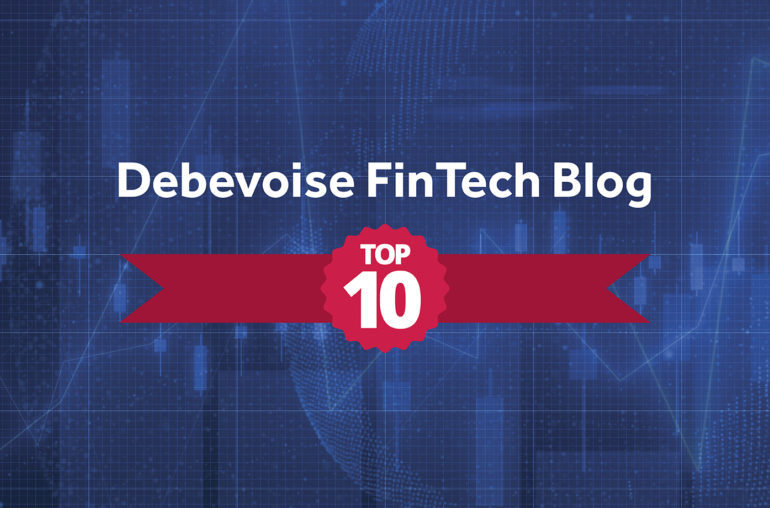As we approach the end of the year, here are the Top 10 posts on the Debevoise Fintech Blog in 2022. If you are not already a Blog subscriber, click here to sign up.
October 10, 2022
In the wake of the industry’s significant bankruptcy filings, crypto watchers are focusing for the first time on which crypto-entities are eligible for chapter 11 relief under the U.S. Bankruptcy Code and, if so, whether and under what circumstances, crypto-assets held by the debtor may become property of the debtor’s “estate.” Once these critical gating questions are answered, one of the next significant issues is: how are the claims of customers whose crypto assets are determined to be property of the estate valued and measured under applicable bankruptcy law?
August 4, 2022
On June 7, 2022, Wyoming Senator Cynthia Lummis and New York Senator Kirsten Gillibrand introduced the Lummis-Gillibrand Responsible Financial Innovation Act, the first comprehensive bill introduced to govern digital assets. In the Debevoise Fintech Blog’s first official webcast, our banking and fintech experts, Alison Hashmall and Gary Murphy, discuss the bill with Chris Land, General Counsel for Senator Cynthia Lummis, and Arjun Ghosh, Finance Counsel to Senator Kirsten Gillibrand.
August 2, 2022
In light of volatility in crypto markets and news of several crypto entities filing for bankruptcy, market participants are increasingly scrutinizing the credit of crypto intermediaries and considering whether there will be an influx of additional filings. In thinking through credit risk, one critical preliminary set of questions that market participants should ask is which bankruptcy regime is likely to apply to a crypto intermediary, what are crypto asset-holder rights likely to be under that regime, and what are creditor rights more broadly. The classification of the crypto entity will impact the applicable insolvency regime and the likely outcome for creditors and customers.
July 13, 2022
One of the key unresolved questions surrounding crypto-custodian bankruptcy proceedings under the U.S. Bankruptcy Code is whether or not digital assets that are held by a crypto exchange on behalf of platform users could be viewed as the exchange’s corporate assets in the proceeding, which in turn could be used to satisfy debts of other creditors. Banks and other financial service providers contemplating or currently offering crypto-custody services through sub-custody arrangements with digital asset platforms may be impacted by this uncertainty to the extent that they hold their customers’ digital assets in omnibus accounts at the exchange.
June 21, 2022
On June 1, the United States Attorney for the Southern District of New York and the New York Field Office of the Federal Bureau of Investigation unsealed an indictment charging Nathaniel Chastain, a products manager at OpenSea, with one count of wire fraud and one count of money laundering for his alleged insider trading of Non-Fungible Tokens. This case marks the federal government’s first indictment of insider trading of a digital asset.
June 3, 2022
Turmoil in the cryptocurrency market brought issues related to crypto-asset custody to the forefront of the crypto currency discourse; in an enormous $1 trillion crypto-asset crash between approximately May 6, 2022 and May 16, 2022, some coins lost up to 99% of their original value. Many crypto-asset investors are now wondering how their assets may be treated if their crypto-asset exchange of choice were to file for bankruptcy. While this question remains largely unanswered, new guidelines issued on April 11, 2022 by the U.S. Securities Exchange Commission (SEC) regarding platforms that safeguard or hold crypto-assets on behalf of users may require additional disclosures on this topic.
March 10, 2022
President Biden signed an Executive Order (the “Order”) outlining, as described in the accompanying Fact Sheet, a “whole-of-government approach” to harness the benefits, and address the potential risks, of digital assets, including risks to consumers, financial stability, national security and the climate. The Order acknowledges the explosive growth in non-state issued digital assets and the rapid development of central bank digital currencies worldwide, recognizing that digital assets have become integral to U.S. and global financial systems. The Order is a first step in the Administration’s national policy for digital assets, largely directing relevant agencies to develop reports and frameworks instead of requiring immediate regulatory action.
March 4, 2022
In response to Russian military action in Ukraine, U.S. authorities have imposed several tranches of new sanctions against Russia, particularly against Russia’s financial industry, including its major banks and the Central Bank of Russia. On February 26, President Biden and leaders of other European countries announced their intention to remove certain Russian banks from the SWIFT financial messaging system, a measure that was enacted by the European Union on March 2, 2022, and applies to seven Russian banks, cutting them off from SWIFT’s secure network for transmitting financial messages between financial institutions (e.g., payment instructions).
February 22, 2022
In a speech at the U.S. Monetary Policy Forum in New York, FRB Governor Lael Brainard continued to tout the potential of a CBDC in the U.S. digital payment infrastructure, while also highlighting potential risks. In this article, we lay out some of the most pertinent takeaways.
February 1, 2022
As the digital asset industry continues to grow, regulators also have grown more and more active in the space. In addition, with cryptocurrency and payments as one of the main use cases for digital assets thus far, it is no surprise that regulators have devoted significant attention to those facilitating transactions in cryptocurrencies and the issue of whether such facilitators should be considered money transmitters.
***
To subscribe to the Debevoise Fintech Blog, click here.
To subscribe to the Data Blog, please click here.






